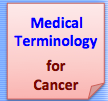Medical Terminology for Cancer
© Copyright 1996-2013
1: Introduction / How to use this guide
Contents
 Introduction
Introduction How to Navigate Around this Guide
How to Navigate Around this Guide Information sources
Information sources Disclaimer
DisclaimerIntroduction
This guide is intended as an introduction to medical terminology with an emphasis on cancer. The guide is primarily aimed at those who may have little or no medical background, and is also hoped to be of some use to those with more experience. It has been written for those engaged in cancer research such as data managers, clinical trial assistants, statisticians, and others. If you are a patient remember always to discuss your concerns with your physician who will be able to provide you with the information which most relevant to you. This guide may be of interest to you but discuss your information needs with your doctor first.
The guide was originally written as a paper based guide to medical terminology for childhood cancer; but now includes reference to adult cancers. Hyperlinks to other documents on the InterNet have been included so that readers can have ready access to more detailed information about specific cancers. For those who are unfamiliar with the InterNet you may first want to read Kevin Hughes' guide to the World Wide Web.In particular there are many links to CancerNet information statements provided by the U.S. National Cancer Institute (the links in this guide are to a copy of CancerNet held in Germany by the University of Bonn). There are also many links to OncoLink produced by the University of Pennsylvania Cancer Centre (USA). Hint: for those in Europe links to the USA will be fastest in the morning before the States wake up !
The first chapter of this guide introduces childhood cancers, the second summarises adult cancers. If you are new to the world of oncology you may already have encountered many new medical terms, some of which are dealt with in chapter 3. Many medical terms can seem complex and intimidating at first. Chapter 4 of this guide aims to help demystify some of these words by showing how they can be broken down into more simple component parts; root words, suffixes, and prefixes.
The subsequent chapter of the guide introduce the main systems of the body, again with an emphasis on medical terminology and cancer. A group of tissues that carries out a specific function is called an organ. A system is a collection of organs that perform specialist functions. These sections have a common structure;
- a summary of the functions of the system and it's organs
- a list of component root words, suffixes and prefixes
- a summary of cancers associated with that system
As you build up your medical vocabulary you may well find it useful to have access to a medical dictionary, and an illustrated guide to anatomy and physiology might be useful.
How to Navigate Around this Guide
The chapters about the body's systems have a similar structure. There are a number of symbols to help you quickly move around the guide (just vlick on the image):

| Go to the Summary / Functions section for that chapter: |
| Go to the section about root words, prefixes, and suffixes associated with that system |

| Go to the section about cancers associated with that system |

| Go to the main index |

| Go back to the main contents page |

| Go to the next chapter. |
Using the index:
Select the first letter of the word that you want to look up from the selector: ABCDEFGHIJKLMNOPQRSTUVWXYZ. This will take you to the section of the index for that letter. Selecting an item from the index will load up the relevant section of the guide
For example selecting O then Osteosarcoma will take you to the section on osteosarcoma in the chapter on the skeletal system.
Information sources
This guide is based on information from a wide variety of sources collected over the last 9 years during which the author has worked in cancer research. The following were especially useful:
- Tortora GJ, Anagnostakos NP. Principles of Anatomy and
Physiology. 6th Edition Harper Collins (1990).
- Dorlands Illustrated Medical Dictionary. 27th Edition (1988)
- CancerNet PDQ statements provided by the National Cancer Institute (USA).
- OncoLink by the University of Pennsylvania Cancer Centre.
- General Introduction to Medical Terminology (course) Leicestershire Health Authority.
- Dorlands Illustrated Medical Dictionary. 27th Edition (1988)
Other sources are referenced at the end of each chapter.
Disclaimer
This guide has been written for educational purposes only, it can not be used for diagnosing or treating a health problem or a disease. If you have or suspect you may have a health problem, you should consult your doctor. No responsibility can be accepted for information on any linked page, please read the provider's own disclaimer where appropriate. Every effort has been made to ensure that the information in this guide is accurate as possible but generalisations and simplifications are inevitable in an introductory guide like this.



This guide by Simon Cotterill
First created 4th March 1996
Last modified: 1st February 2014


 CancerIndex
CancerIndex